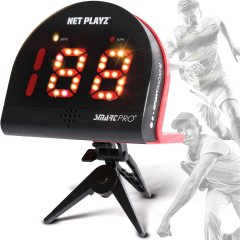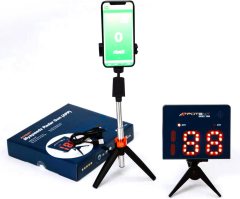BestReviews is reader-supported and may earn an affiliate commission. Details

Athletes in training will appreciate the wealth of handy features that this handheld speed tracker incorporates into its simple design.
Athletes in training will appreciate the wealth of handy features that this handheld speed tracker incorporates into its simple design.
Impressively accurate. Hands-free and remote control operation. Up to 48 hours of battery life with a power pack. Includes batteries. Bluetooth connectivity. Convenient companion app.
Its power runs out quickly when using AAA batteries.

If you need to note the speed of a baseball or speeding car at a glance, this Bushnell radar gun is a suitable option.
If you need to note the speed of a baseball or speeding car at a glance, this Bushnell radar gun is a suitable option.
Affordable. Crystal-clear LCD. Impressively accurate readings. Max speed of 200 mph. Simple, streamlined design that is both lightweight and easy to hold during an entire practice session. Only needs one AA battery.
Lacks extra modes seen in pricier models.

Simple and reliable, the Pocket Radar Ball Coach is the best radar gun for athletes who need an accurate and easily portable radar gun.
Simple and reliable, the Pocket Radar Ball Coach is the best radar gun for athletes who need an accurate and easily portable radar gun.
Extremely accurate. Maximum range of 120 ft. Tracks speeds up to 120 mph. Hands-free operation. Fairly priced. Includes wrist strap, two AAA batteries, and holster. Great for those looking for something easy to use.
Incompatible with the Pocket Radar companion app.

A simple radar gun that works well for measuring pitches and serves.
A simple radar gun that works well for measuring pitches and serves.
With a large and bright display, this is a useful radar gun for solo practice. Capable of measuring speeds from 0 to 150 mph. It can also measure speed in kilometers per hour.
You must throw toward the radar for an accurate reading.

Pairs a reliable radar with an app that tracks your performance over time.
Pairs a reliable radar with an app that tracks your performance over time.
While this radar works well just using the radar and its readable digital display, its app allows you to analyze your speed history. The tripod is easy to adjust, and the small form factor of the unit allows you to take it on the go.
Readings sometimes pick up the incorrect object.

We recommend these products based on an intensive research process that's designed to cut through the noise and find the top products in this space. Guided by experts, we spend hours looking into the factors that matter, to bring you these selections.

Ready to buy now? Shop the best:
If the first thing you think about when you hear the term “radar gun” is speeding tickets, think again. While police certainly use them regularly for traffic control and monitoring, radar guns also have uses in areas that are a bit more fun.
Radar guns have the ability to measure the speed of various objects, not just cars. Athletes and coaches use radar guns to measure the speed of a thrown ball, a struck ball, a racket, or a club head. Measuring these speeds can help athletes figure out if they’re using the proper technique. A loss in speed of a ball or club can provide an early indication of injury, too.

Technology
Radar guns are frequently used by police to measure vehicle speeds for traffic enforcement. Radar guns are also used in sports. There are two technologies used to measure speed: the Doppler effect and laser.
Doppler effect: A radar gun that relies on the Doppler effect sends radio waves toward the target. The radio waves strike the target and bounce back to the radar gun, which measures the change in frequency of the sent and received waves. That change is the Doppler effect. The frequency change enables the radar gun’s software to determine the speed at which the target is traveling compared to the radar gun. All of this happens within a fraction of a second, making it appear instantaneous.
Laser: Instead of radio waves, some radar guns use a laser light to measure speed. This type measures the time it takes for the light to reflect off the target and return to the radar gun. The police use laser radar guns to track traffic speeds. You won’t see these radar guns in use at baseball stadiums.
When measuring the speed of a baseball or softball pitch, the location of the measurement affects the reading. A ball is moving more slowly when it crosses home plate than when it leaves the pitcher’s hand.
Uses: While using radar guns to measure vehicle speeds is common, you’ll also find these tools used in sports. Radar guns are regularly used to measure the speed of pitches during a baseball or softball game. Statisticians measure the speed of the ball off the bat (exit speed velocity). Radar guns are also used to measure the speed of the puck in ice hockey or serves in tennis. Golfers use radar guns to measure ball speed or the speed of the swing of the club.




















Radar guns made for home use have some interesting designs and feature sets.
A common radar gun design is a shape that resembles a handheld drill, with the trigger on the handle. The front of the radar gun has the radar mechanism, while the back has the display screen and control buttons.
Some newer radar guns look more like smartphones in shape and size. You hold this style of radar gun with the screen facing toward you and press a button to activate the radar. You can also attach this type of radar gun to a tripod to make it easier to use.
You activate a radar gun with a button or trigger. Many also provide a continuous mode in which the radar gun can be set up to work hands-free and automatically measure speed.
Some units offer a mode that displays only the maximum speed of the target during the testing period. Others store a range of speeds during the time of the test.
Radar guns are not cheap. While it might seem like fun to grab a radar gun to find out how fast your eight-year-old can throw a baseball, it’s going to cost you.
Even basic radar guns cost $100 to $200. They provide a reasonable level of accuracy to within a couple of miles per hour. These radar guns are easy to use, but they usually don’t offer much in the way of advanced features, such as memory to store readings.
Advanced radar guns cost $200 to $500, but you can find some units that cost $1,000 to $2,000 or more. These expensive radar guns are very accurate to within one mile per hour, and usually less. They consist of high-quality, durable materials and can be used in any weather. These models may also fit on a tripod.

Use a radar gun for baseball or softball. Pitchers want a measurement of the maximum speed of a pitched ball. Many radar guns made specifically for baseball and softball automatically display the top speed, and some units can measure both the speed of the ball at the point of release and the speed as it crosses the plate. Additionally, most baseball and softball radar guns can measure the throwing speed of fielders and the exit velocity of the ball off the bat.
Use a radar gun for tennis. You can use a radar gun to measure the speed of a served ball, which is similar to measuring the speed of the ball out of a pitcher’s hand in baseball or softball. You can often use the same type of radar gun for both sports.
Use a radar gun for golf or hockey. Measuring the speed of a golf club head or a hockey stick gives coaches data about the efficiency of a shot. Some of these radar guns sit on the ground, aimed at the point of impact. Having a radar gun that can store 25 to 50 readings is especially nice in this case because you don’t have to stop a practice session to write down each reading.

Q. Are police radar guns really all that accurate?
A. They are extremely accurate, usually to within one mile per hour (and often significantly better). However, to maintain that accuracy, they must be calibrated and tested on a regular basis. If you’re questioning the accuracy of a particular radar gun, verify that it has been calibrated recently. The calibration needs to follow the manufacturer’s recommendations.
Q. I notice baseball radar guns sometimes list the pitch speed to tenths of a mile per hour. Can they actually be that accurate?
A. The answer is yes, but it depends on the model. Most models you buy for use at home are only accurate to within one to three miles per hour. More expensive professional radar guns, such as those used by Major League Baseball teams, are accurate to 0.1 mile per hour.
Q. Where should I place the radar gun to measure speed?
A. For a radar gun using the Doppler effect, the gun must be pointed in the same direction the object is moving. This style of radar gun only measures the speed of an object moving toward the gun or away from it. Place the radar gun in front of or behind the object being measured.
Q. Does precipitation affect a radar gun’s performance?
A. No. Radar guns continue to work accurately even in rain or snow. However, you will want to be sure the radar gun is weatherproof and waterproof before you use it in poor weather.
Get emails you’ll love.
Learn about the products you’re wondering if you should buy and get advice on using your latest purchases.
